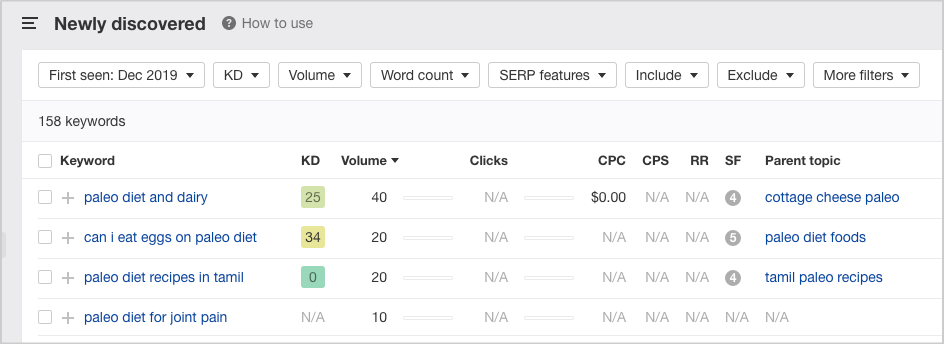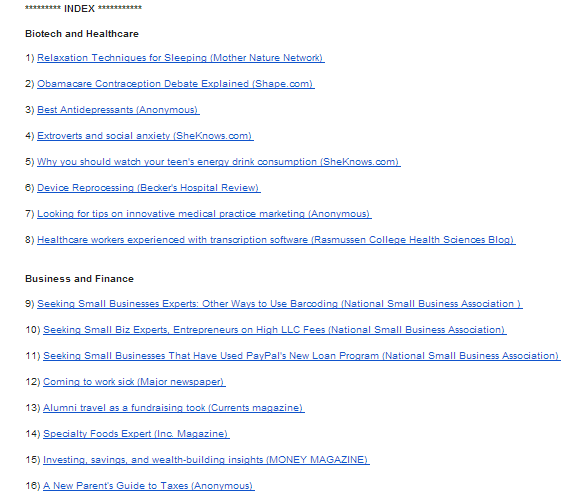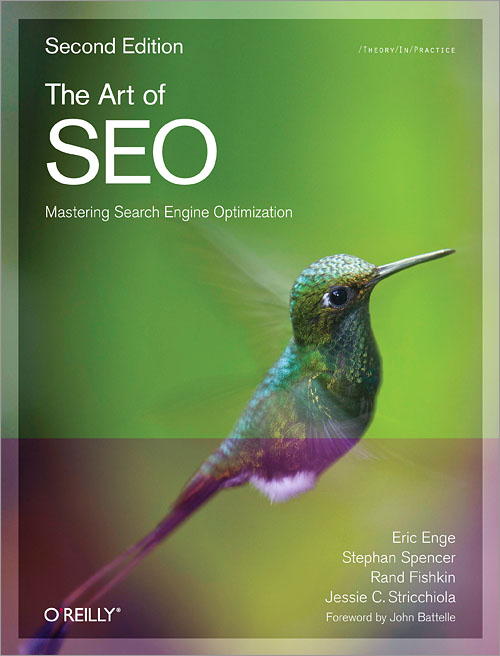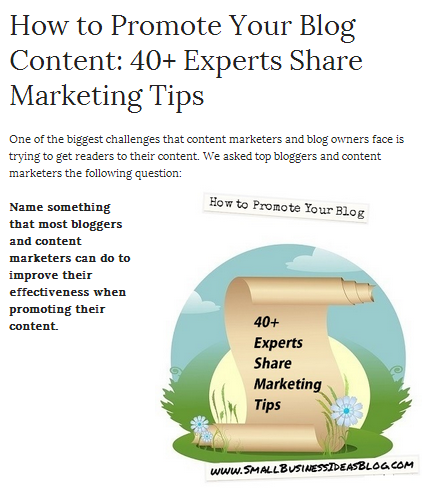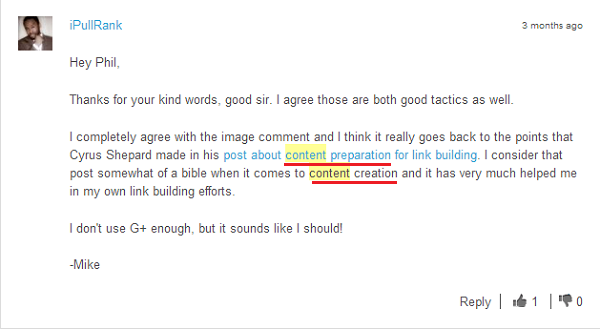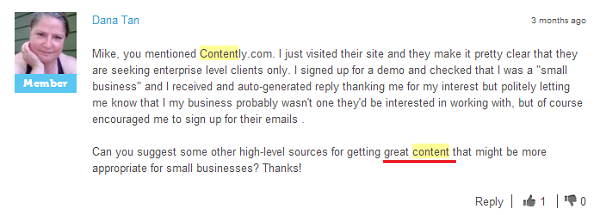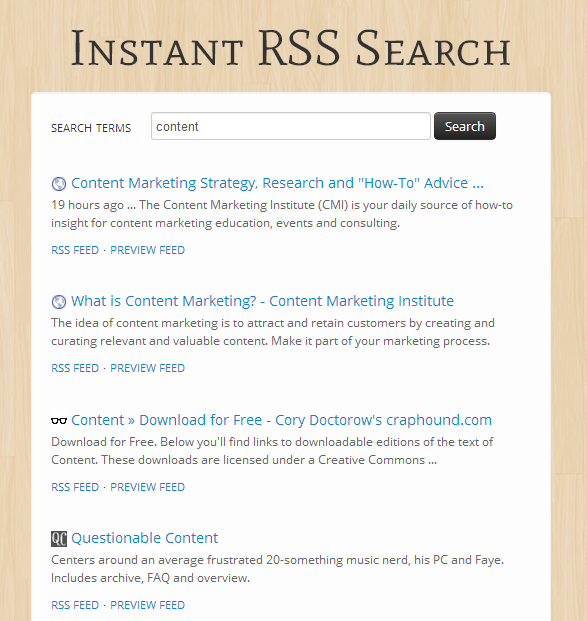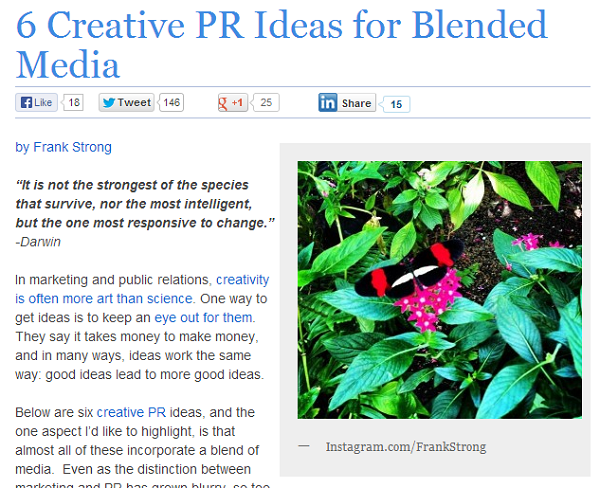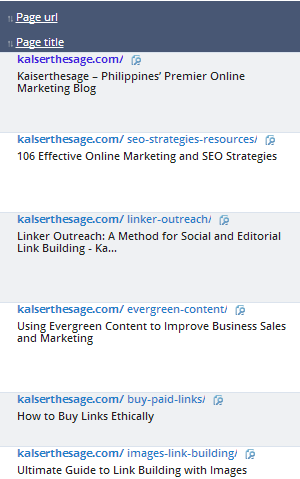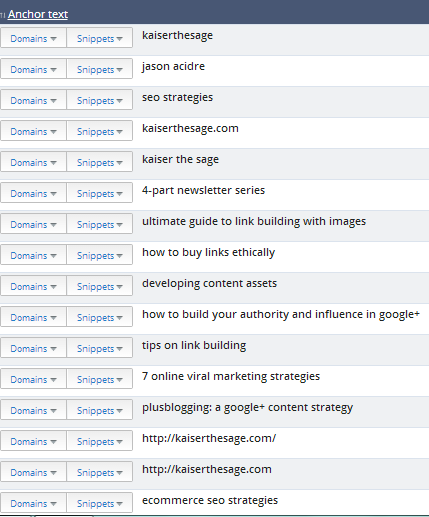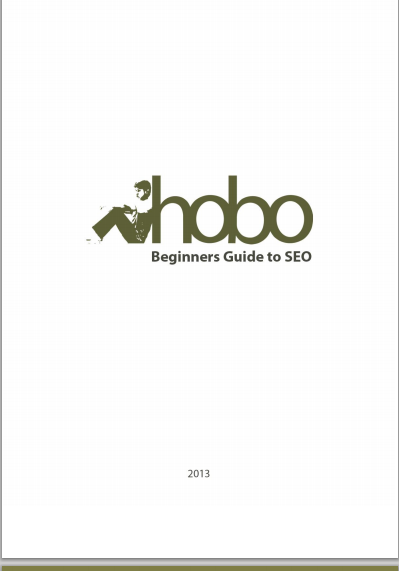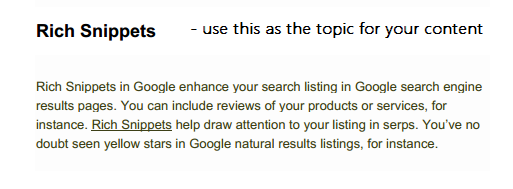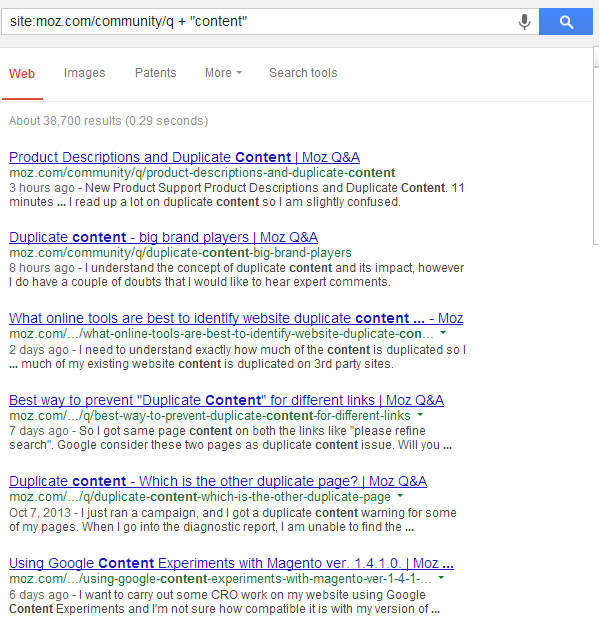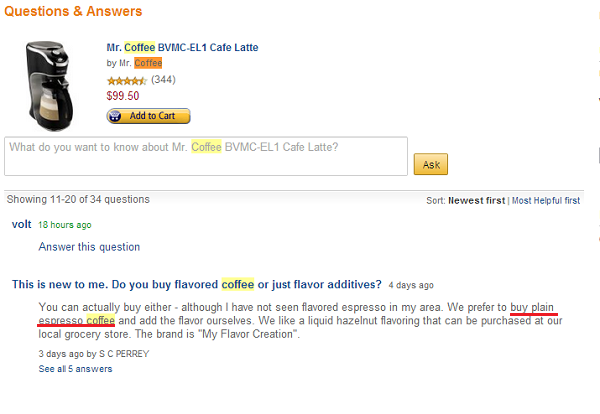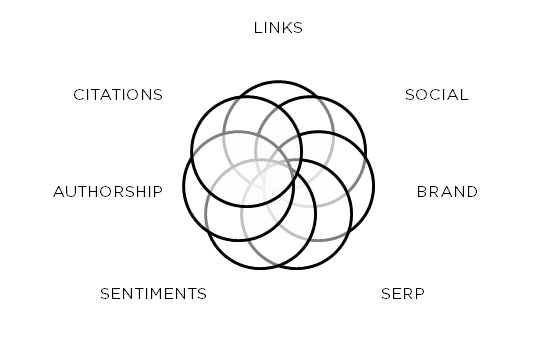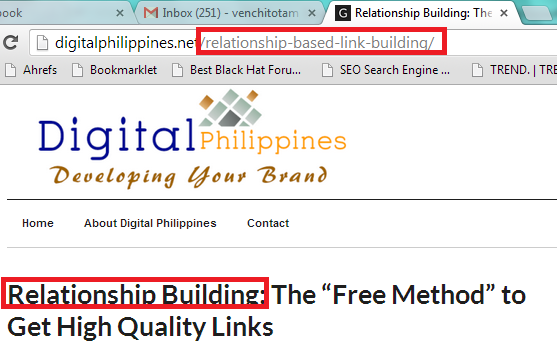How to Create Link Assets in Boring Niches
The reality is not all industries are fun to create content with.
There are what we call "boring industries" that you won't take much pride in content creation and promotion.
But that's just because you find it boring doesn't mean there's no way to pursue linkable asset creation.

In this post, we'll discuss three ways to create link assets in boring industries.
1. Generate Safety-Focused Content Ideas
Topics on safety have never been more linkable than ever before. Particularly, in this Covid-19 season when people are experiencing tough times, producing content for safety can help your site earn natural links.
Start generating safety resources, including MSDS.
Material safety data sheets (MSDS) are documents that contain information on the potential hazards (health, fire, reactivity, and environmental) and how to work safely with the chemical product.
These may be a little bit industrial or too technical as you think, but safety-focused content just like this can generate tons of links.
Another way is to tap the safety needs of your target audience.
Safety needs, this pertains to four types:
- Financial
- Emotional
- Physical
- Social
Depending on your industry, you can think of ways on how to create content that gives information on any of the four safety needs.
By simply using common sense, you can think of ways on how to generate content ideas quickly.
Lift Maintenance Example
For example, if you're working on a "lift maintenance" — social safety is of top priority.
A content that answers "what to do you do if you go to get in an elevator but see someone else is already in it?.
An even shorter version of link asset would be this: "Social Distancing Inside an Elevator".
Insurance Example
Another example is the insurance space.
Any information to help a specific group of people stays financially safe during economic hardships is a great content idea.
Start thinking of ways on how to teach people with saving, making, and spending money. By looking at financial safety as your main agenda for link assets, you can quickly generate ideas for yourself.
Learn from highly linkable assets in boring industries.
You don't have to reinvent the wheel all the time. Find content pieces that have gained massive links in the past — to give you some inspiration as to what format of content works.
Here is a good example of an interactive guide on home protection. It deserves the title, "ultimate guide", as the link asset covers information in a very visually appealing manner.
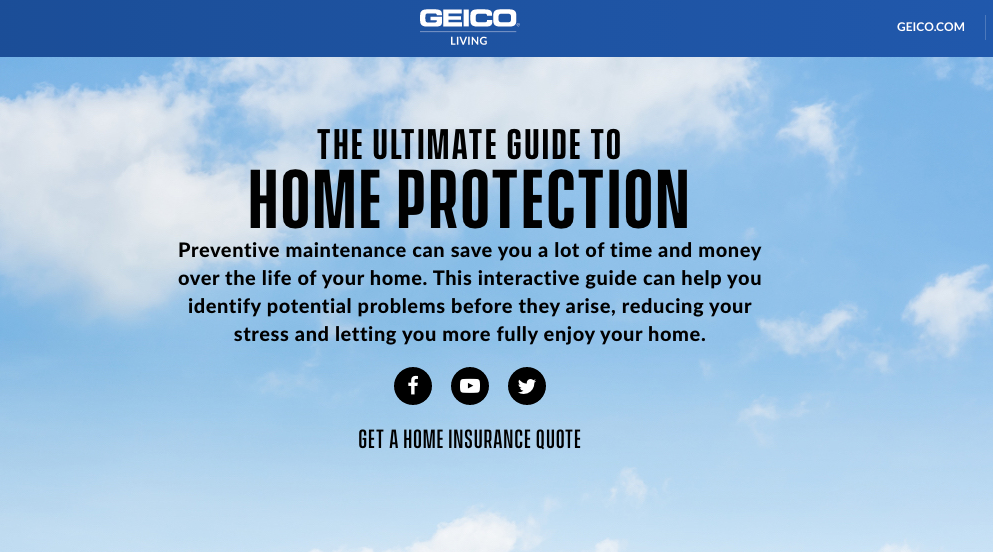

By looking at what other successful content creators in their respective industries, you can replicate some formats and methods of creating content and apply it contextually to your own brand.
2. Appeal to Educators
The best way to build edu backlinks is to appeal your content to educators.
Educators are looking for link assets for targeted audiences, including:
- Comprehensive cheatsheets
- Job-seeking guides for students soon to be working in your niche
- Faculty member discounts and deals
- Research-driven piece featuring educators and practitioners
By building link assets targeted to students, faculties, and expert practitioners in the academe, you'll get chances of creating backlinks from high trusted websites — particularly, from .edu websites.

You can proceed to find resource pages that fit your link assets. Reach out to them and share them with your content piece. There are many library guides on different subjects that will be niche-relevant to your space.
You can check out these guides on broken link building and resource page link building to learn more on how to leverage links from resource pages.
You can also collaborate with current contributors to edu blog sections. These are regular writers for the edu blogs that are giving out information for their readers.

By learning about their writings, you can identify if they're externally linking to references outside their own webpages. This way, you know if you have chances of getting editorial links from their future content.
Start reaching out to them and share the link of your link asset.
For example, this energy plan comparison website produced an animated guide to the science of wind turbines.
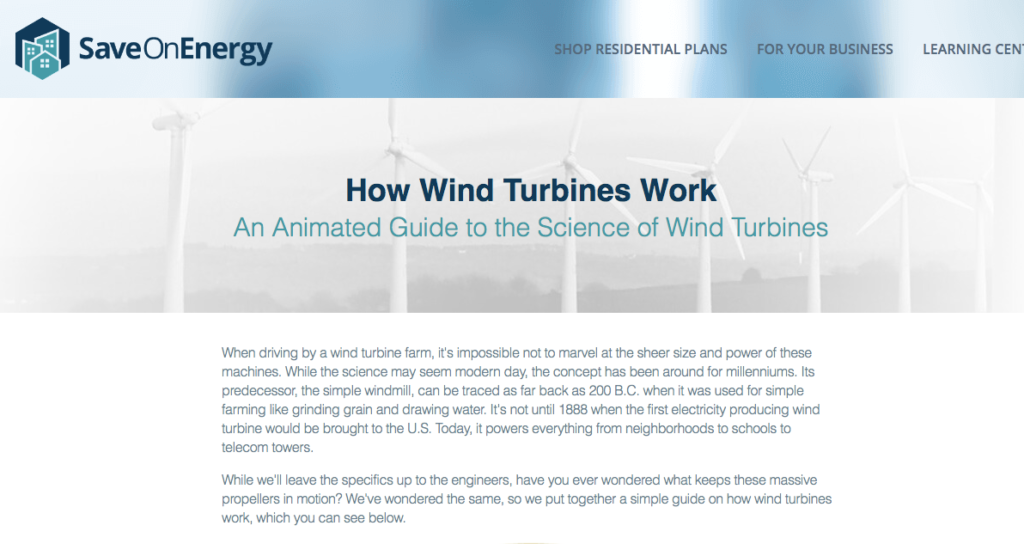
Because of its design and well-meaning technical information, it got links from edu blogs — increasing the visibility of the content to its intended readers.
3. Develop Newsworthy Data-Driven Content
If you think your industry is boring, why not check out some data available online and see how you can turn them into amazing content pieces?
Here is a list of data sources you look upon some information relevant to your brand.
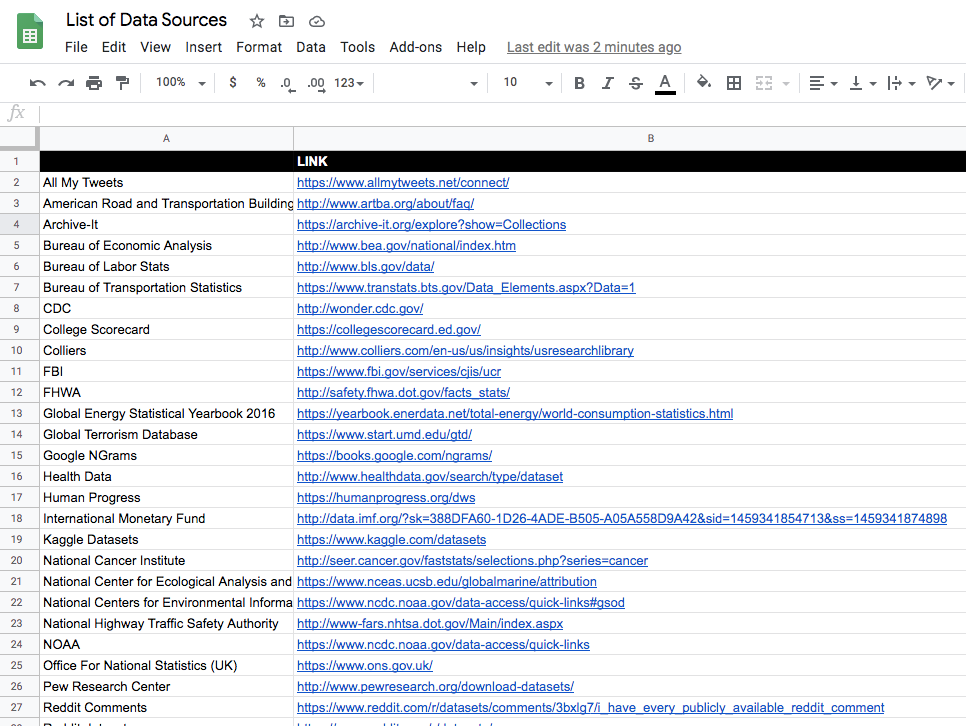
You can also learn from how other data-driven content has been putting information out there and to make your link building campaigns more effective.

Going back to our previous example of a lift maintenance company, you can apply the same concept.
You can research on interesting lifting things and compare them in apples to apples way. Design the piece with styles to make it more attractive to content consumers.
Always make sure you do some research first for any data you'll be putting out on your blog. That may be apparent, but I find content creators lacking the diligence to sift through information — leading to mediocre content work.
Your Niche May Be Boring But Don't Be a Boring Content Creator
Pursue excellent content creation despite the lack of energy and creativity to find "fun" in creating link assets.
What I've shown you earlier may give you insights into what type of content will best work for your industry. Be more diligent in tapping existing linkable markets. It's one of the best ways to start your link campaign for a boring industry.
Start with that. Learn from other brands that have successfully produced high performing link assets.
7 Ways to Discover Unique Blog Ideas
Choosing blog topics is a difficult task for most content creators.
It entails several challenges including:
- knowing if your blog idea will resonate your audience
- checking if your content idea fits your brand's content theme
- identifying the uniqueness of your blog topic
The last challenge may hit you big.

In today's environment where most entities and personalities are dishing out more content than the normal frequency, it's important to understand how to be different, and not just be better.
Be Different in Content Topics
There are companies and individuals who are better than you in producing content. They may have bigger budgets in content production, and at most, are very creative in their content assets.
What do you do if that's the case?
You think of ways on how to make your content different. It starts by discovering unique blog ideas.
These unique blog ideas are not 100% original. That will be apparent. But the seven tips I'll be sharing with you will help you generate unique blog ideas for your website.
7 Ways to Discover Unique Blog Ideas
Here are seven unconventional ways to come up with blog topics that will resonate with your audience.
1. Generate topics from bigger content assets
Brands with consistent blog post-production have bigger content assets than what the most usual niche bloggers publish on their sites.
This is where you can take advantage of their long-form content pieces.
For instance, if you see chapter guides, you take a look at each chapter and see if you can expound and/or elaborate it on your blog.
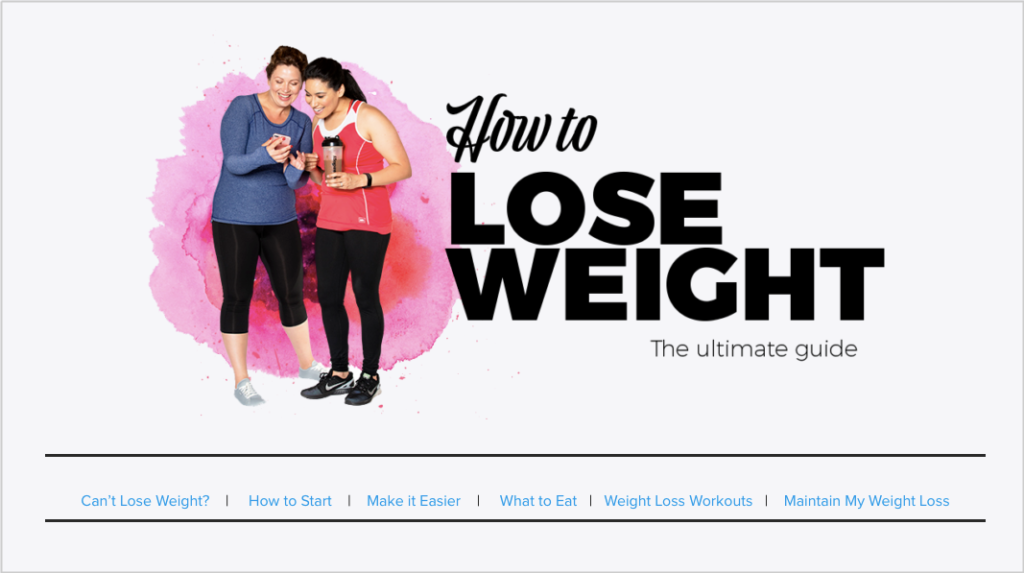
In each chapter page, there are more topics you can expound further depending on how specific it is and how it is possible to get it discussed on a separate page.
Besides chapter guides, you can also check ebooks of brands you're in with the similar content themes.
Go look at each chapter and specific points included. Check if a topic you've seen can be an idea for your blog content.
2. Discern emerging topics
In any industry, there are many topics that arise from the increasing demands of consumer needs and the positive effects of technology.
This gives new topics to consider for blogging.
For this process, you can use Exploding Topics. It is a website co-created by Brian Dean of Backlinko to help you discover growing content topics before they take off.
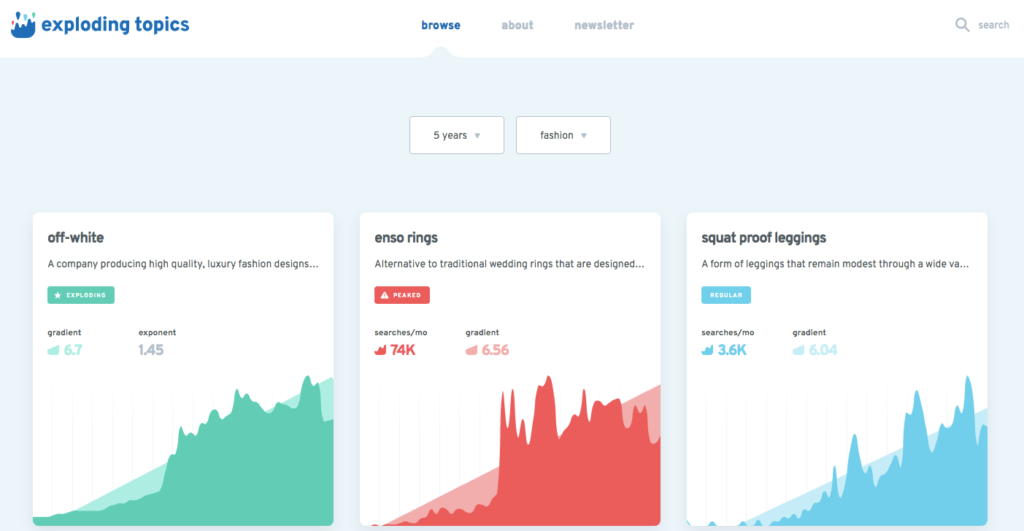
By tapping into emerging topics, you are able to create blog posts that your competitors may not have even think of. This kind of initiative gives you an edge from a content marketing perspective, as you can differentiate from many other similar content creators.
Another tool you can use is Ahrefs. Use it to find new keywords relevant to your blog.
3. Use 'Socratic Questioning"
To be different, you need to ask deeper questions for your content.
Why is it so?
By asking questions, you get the right answers which may lead to better insights about the topic.
One of the ways to leverage this technique is Socratic Questioning. Using this method, you can unearth points and niche topics that will be helpful to your audience in understanding concepts and frameworks on a deeper level.

The Socratic way of questioning has some objectives to help you derive great answers. These include:
- Explore complex ideas and to get to the truth of things
- Open up issues and problems
- Uncover assumptions
- Analyze concepts
- Distinguish what we know from what we don't know
- Follow our logical implications of thought or to control the discussion
The way you can apply Socratic questioning is to get all your possible topics and to scrutinize them using the objectives above. By doing so, you uncover some more points which can serve as individual topics for your blog.
4. Get into the mind of your audience
Know your audience's needs. This may come in the form of finding their frequently-asked questions.
The go-to site for questions is Quora. You've heard it before. In fact, I've written a whole guide on how to use Quora marketing for businesses. You might want to check that out.
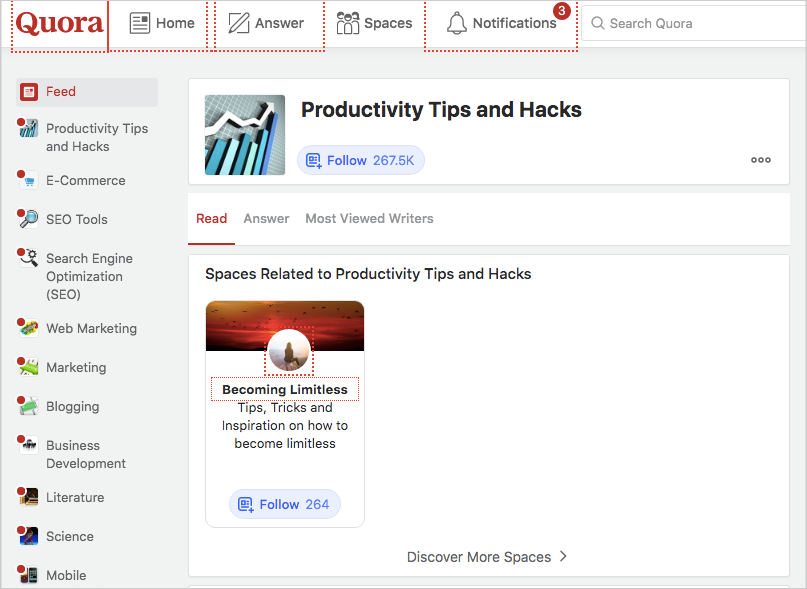
Another platform where you can discover people's questions is Answer the Public. By searching for your keyphrase, you'll find a wide array of questions you could consider as unique blog ideas.
Ahrefs also has a feature for 'Questions' keywords. Utilize it to discover more industry-related topics for your blog.
Lastly, you wouldn't want to miss out on participating in niche subreddits. There are industries where Reddit users ask the toughest questions to the community. Take advantage of it as it could open up new insights for your blog post ideation.
5. Learn from your content competitors (don't just mimic)
Competitor research is a critical aspect of content marketing. With this initiative, you'll find ways on how you attack your content in such a way that differentiates your brand from its blog contemporaries.
Don't just mimic what your competitors are doing with their blog content. Make sure you learn from how they produce their content pieces.
One way to do that is to identify their pages that sending constant traffic to your prospects or competitors. These are basically top links from other sites linking to your competitors' content.
In this case, we use Ahrefs' Referring Domains feature to find out those linking pages.
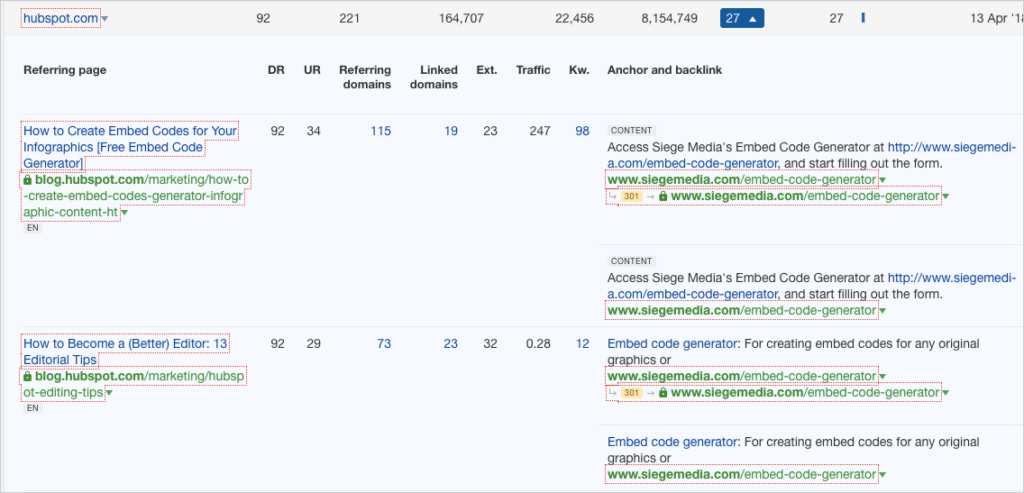
What you are looking at here are blog topics that have demand attention from people in your space. These are within areas in your industry that your target audience would likely engage in.
Check those linked-to pages and see how you can create a better version of those pieces. You may also find it to use "created a better piece on… " as a value proposition when pitching potential prospects for links (when you reached out to linkers to your competitors' most-referred-to content - examples is blogger outreach).
6. Take notice of where you are exposed
Your brand has been exposed for years that get you earned mentions from relevant publishers and news websites.
Take advantage of brand mentions as you'll be able to generate more unique blog ideas through those.
By looking at the topics of content where publishers mentioned your brand elements or your content piece, you can see ideas that get attention from content consumers in your industry.
There are web-based tools to help you with tracking mentions and alerts about your brand or your content asset (whether that's an infographic, video, or article).
Two recommended tools are BrandMentions and Google Alerts. Start tracking places where you have been exposed and get unique blog post ideas from that.
7. Leverage content gap analysis
Content gap analysis helps you accomplish the objective of putting out content that your competitors have already discussed.
While that may sound mimicking only your competitors, you only use that as your headstart. Along the process, you find points of differentiation when you looked at your competitors' similar content.
I've covered this entirely on my guide on content gap analysis - you may want to check this out as your reference.
Further Resources:
- How to Start a Blog - Beginner's Guide to Blogging
- How to Use Blogging For Personal Branding
- How to Build Relevant and Authority Blog Links
Key Takeaways
Identifying and pursuing blog post ideas that are unique can help your brand elevate its differentiation in your space. With tools and proper planning and research, you'll be able to produce content pieces that get more eyeballs than the usual attention.
Apply the seven tips to generate blog ideas to your own context. Know what works.
How to Use Content Inventory For Effective Link Building
Content production may reach a limit where resources are maxed out. This is when you need to look at your current content inventory and see which content assets can be reformatted, reproduced, or repromoted.
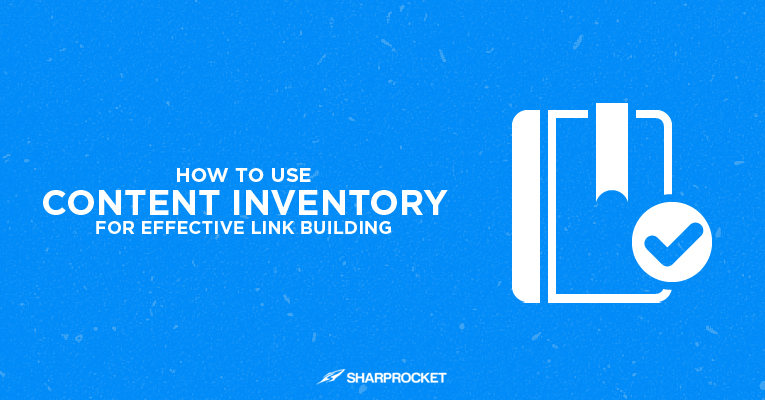
Whatever action you choose, your refreshed content will be of great use to gather more eyeballs in the form of social shares and backlinks.
What is a Content Inventory
Patrick Hathaway of URL Profiler defined content inventory as:
“A content inventory is a complete listing of every page on your website, with associated meta information and metrics, which allows you to make both general and specific evaluations of your website content.”
Essentially, content inventory gives you the exact data of which page to consider for repurposing.
You don't want to waste any resources you've exerted before for a given content asset. You take the time to see them again and use for current content marketing and link building campaign.
How to Use Content Inventory for Link Building
Here are some tips to get the most out of your resources when assessing the content inventory for link acquisition.
1. Identify content archives worthy of updates
Look for any pages that are either high-performing in terms of content engagements (links, shares, traffic, etc..) or under-performing — ones that may need some updates to be relevant for current topics.
You can use a variety of tools below to help you generate quick data of your webpages:
And here are some tutorial videos to get you started with those tools.
Once you have a list of pages at hand, take a look and see which are relevant content.
Generally, those are pages that would need more updating to match current events. For example, in today's Coronavirus situation, which pages would be resonating with your target people?
Are there are any evergreen topics about cleanliness, helping people in need, remote work, positivity, and parenting at home?
2. Dig into pages for BLB promotion
If you're active with producing linkable assets to build your brand authority, you're likely to have several content pieces in your content inventory.
Those linkable assets may include resource guides that have experienced one phase of promotion, either through simple linker outreach or broken link building type of activity.
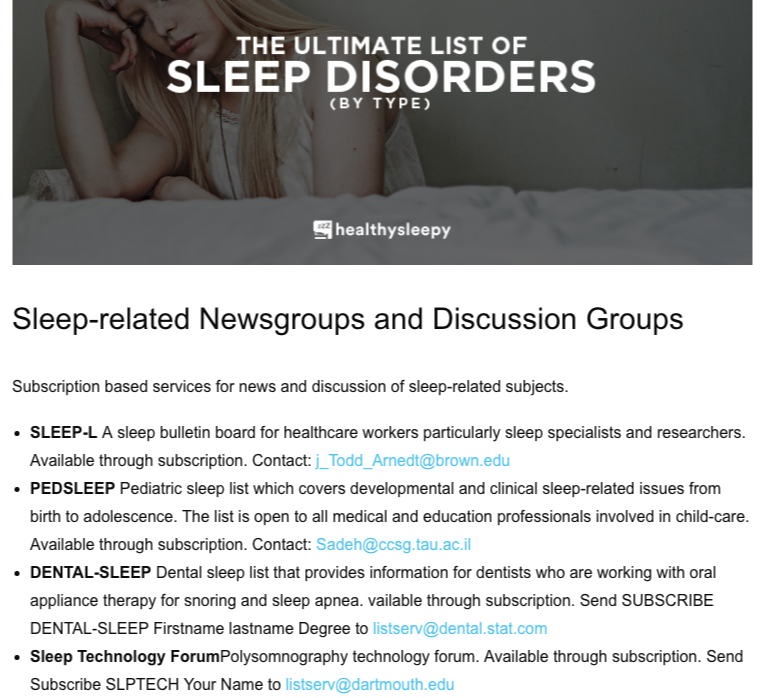
Can you promote a resource guide to new groups of linkers? Remember, there are new industry curators who have not been part of your first round of content promotion.
Start gathering new link prospects for your resource page. Add them to your existing list of linkers.
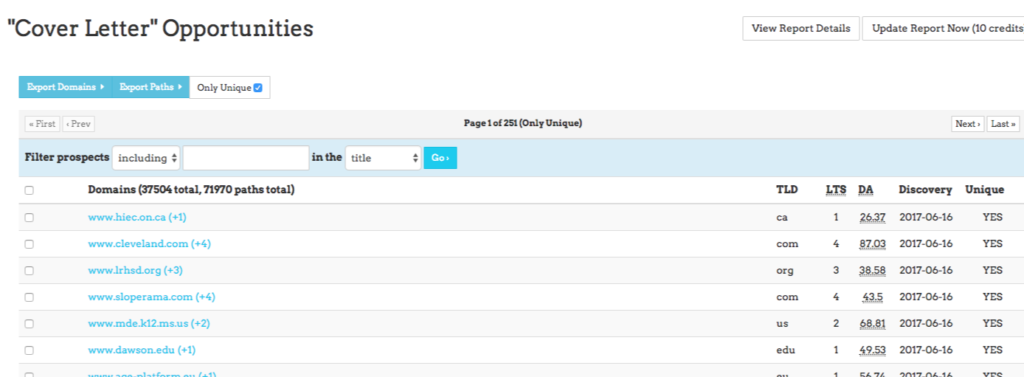
Then do the necessary steps to do some outreach.
Seek to do have a second round of outreach for your past linkers who didn't respond to your initial pitch—reconnecting after a few months to see if they're able to link to your resource content.
Sidenote: During this Coronavirus crisis, people are likely to respond to resource page requests given most (if not all) are working from home and have more time and means to edit webpages.
Another way to increase your link placements for a broken link building outreach is to think of angles that will resonate with your audience — tapping the current events.
For example, instead of sharing your parents' guide to getting kids to sleep better, why not consider an outreach angle that focuses on more activities like bedtime stories — helping parents to engage with their kids better.
By looking at your past resource guides that have garnered links, you'll be able to strategize ways to repromote them for other rounds of broken link outreach.
3. Generate ideas for future content pieces
Another advantage of taking a content inventory is you're able to spot topics that have resonated with your audience.
This means that your target audience has seen your content relevant to theirs and find it useful to what they are currently doing.
Essentially, you want to look for niche ideas that don't just capture their audience but have a lasting impact in solving their needs. The higher the contribution factor your linkable assets has to them, the more it generates value. Thus, it gives your content piece more chances of earning links.
Look at your past content pages. You can use Ahrefs to find highly linkable content assets. See from a link builder perspective which piece has generated a good number of organic links.
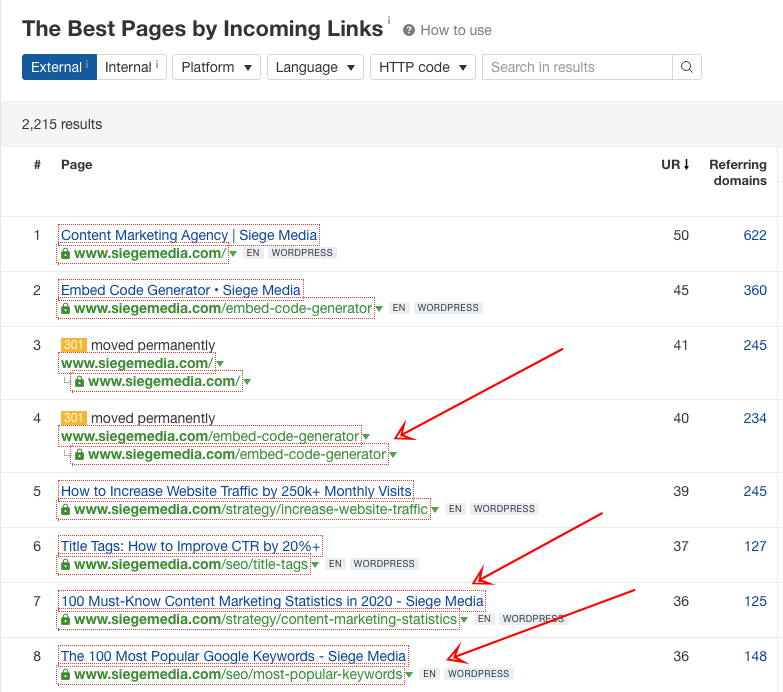
Are there any topics that keep on getting traction from time to time? Is there seasonality with the titles of your assets?
You may even search for those linked to your pages. And analyze how people link to your piece. Did they reference it to support their claims or information? Are those references can be repeated to other groups of linkers?
4. Build internal links from top linking pages
Internal links are as important as inbound links.
Identify pages that can earn links on their own. Start internally link to them from pages that need more link equity to boost their search visibility.
5. Match old content to current search strings
What separates a highly successful outreach campaign from a mediocre one is the ability to match content to search strings of people are using to find what they need.
Instead of searching for potential linkers with common search strings like "parenting tips" to find blogs whom you can reach out to for links. Use "parenting at home"-like key strings to match and serve the needs of people of today's current event where parents are at home.

Further Resources:
Put Old Assets to Good Use
Having a regular audit of your content inventory is essential to build momentum with your content marketing and link building campaigns. Take your resources to good use by repurposing assets and/or repromoting them to targeted audiences.
How to Outsource Content to Writers
Outsourcing content to writers is never easy.
Though you can simply post a job ad and onboard a writer instantly, you won't guarantee success in your hiring just like that.
Make it a hurry to hire content writers and you lose money and time in business. It is better to follow a specific process to get qualified content creators that can help scale content marketing for your website.
Before I discuss the steps to outsourcing content to writers, let's understand the benefits of doing it.
Benefits of Outsourcing Content to Writers
Scalability
I'll be speaking on behalf of an agency that is churning out hundreds of content for our clients through our content marketing and link building services.
Doing so requires a lot of work.
Outsourcing content writing to credible writers frees up the time to write content work itself which allows us to focus on other sides of the business.
The same can be true for you. Outsourcing is done to free the legwork out of you and reduce the time spent on long-term content (time-consuming) creation itself.
That's not to say you don't get involved in the process. But with two or three people working with you, you can be scalable in content creation in a very timely manner.
When content creation is covered, your team (people who are involved in content marketing) can spend a lot of time promoting content assets.
Given that this is where most brands get caught up, they keep producing content assets on their blogs without even promoting them massively on target audience websites.
This shouldn't be the case. Create content and promote it so you can get the results you desire for your campaign.
Leverage other people's expertise
As I covered in my guide on creating linkable assets, you have three options in content production:
- Do it yourself or with your team
- Hire freelance writers
- Look for industry practitioners who can write about your preferred topics
In hiring freelance content writers, you can vouch for the last option.
They may not be easy to find, but if you find one or two, you can expect a better quality of writing for your blog.
There are many other benefits of hiring freelancers for outsourcing content creation, but let me go straight to the steps on how you can outsource content to writers.
How to Outsource Content to Writers
Step 1: Decide on the type of content writer to hire
You can either hire a freelance writer with a generic background in your industry or hire an industry practitioner who does freelance work.

Your basis here is the type and format of content you are eager to create.
Are you looking for content backed up with research and case studies? How about someone who can walk through readers with a step-by-step process on achieving a goal or a review on using an industry tool? Those things certainly require someone who is a practitioner in your field.
Even the brand voice and style of writing depend on your current content strategy (if you have one). Are your writings more conversational in nature or it is purely academic?
Those matters will help you decide on the type of content writer that suits your needs.
Step 2: Look for credible content writers
Don't just find any writers who write pieces of content. Filter out any blog post creators who don't have any experience in technical writing about your industry topics.
You want to ensure good quality in your content produced by people you're looking to hire.
The question here is where to discover content outsourcing writers.
Referrals
Start asking your networks if they know a freelance writer who can write for your brand.

Potential writers vouched by people you know are good recommendations.
Your contact/s can speak about the credibility of writers they've worked with (or know). You could also ask them about the writer's writing output, communication style, and other pertinent matters you think are worthy to consider.
Besides referrals, you can opt to post job ads on top freelancing websites.
Freelancing websites
Here are top freelancing websites where you can post your job ad:
- UpWork
- PeoplePerHour.com
- Guru.com
- Problogger Job Board
- BlogExpose.com
- BloggingPro.com
- FreelanceWritersDen.com
There are of course other freelancing platforms or websites specific to freelance writers, but the ones I've mentioned above are the best places to start your prospecting.
When posting job ads, it is best to use any applicant filtering techniques.
One that I recommend the most is adding lines to your job description, such as using "bacon" or "breakfast" in your subject line or any words or phrases variable to your job description.
You'll find that this is an effective way to weed out applicants who don't have attention to detail.
In addition, you can see applicants who are very creative in their applications. Instead of just putting "bacon" or "breakfast" in the subject line like "bacon content writer position", they write creative subject lines such as "Baron & SharpRocket team eat bacon for breakfast win".
Step 3: Assess your writers through tests
There are several factors to consider when choosing the best freelance writer for your site, but here are the top ones we always check.
Request sample work
At most, you'll find writers who have sample works ready to submit to employers.
While I don't judge quickly, in our experience, the quality of sample kind of content isn't always the same as the actual writing once you hire them.
It is best to get them to write a paid sample work. If you are involved in the content ideation process, you can send a list of specific topic good ideas they can choose from and create content.
There are two advantages of doing so: you get content that you can publish on your blog (if it fits your quality preference) and you get to see the actual work for the writer.
That is why it's important to choose the top one or three freelance writers you really vouch for from your prospecting strategies, so you don't have to pay a huge amount just for samples of work.
Compare rates per article
Communicate to your top prospective writers on their rate per article. This is a good basis when choosing which one fits your budget. You can ultimately hire the person as an in-house great writer if it's a better option for cost preference.
Know their payment preference
This is another factor that other articles on outsourcing content writers don't include.
While there are payment options available like Paypal, Payoneer, or international transfer wires, remember that freelance writers from other countries may not have the same payment option you prefer.
Get that matter discussed earlier when assessing a potential content writer.
Communication
Whether you communicate with the writer through email or on freelancing platforms, you'll get a sense of the response time of the writer.
This is crucial in the onboarding and content creation work, as you don't want delays to happen with your content.
Step 4: Hire your preferred content writer
Once you assess content writers and hire the right one for you, have a proper onboarding process.
These are some matters you have to brainstorm and finalize:
- Overview of your company (and the style and process of sharing it with your newly hired content writer).
- The flow of the content creation process (from content ideation to publishing)
- Turnaround time for each phase of the content creation process
- Payment preference and system
For the last part, it would be easier if you have a payment preference for content writers. Whether you choose an upfront payment option (half of the cost is paid before the writer starts writing the content) or full payment upon completion of work.
Step 5: Create a workflow for the content creation process
The process is key to scaling your content marketing campaign.
Without the proper workflow, there will be miscommunication between you and your content writers. It's important that they understand well the importance of each phase and how well each phase is integrated into one another.
One thing you don't want to miss here is the discussion of the turnaround time per content. Each content depending on the type, length, and subject matter has a specific range of days to get finished.
Start brainstorming (with your team) of a good content creation workflow dedicated to freelance content writers.
Step 6: Build stronger relationships with content writers
Employ empathy when dealing with freelance writers. Their creative professional side may be affected by many different factors that don’t involve work.
A quality 1-on-1 meeting with each of your content writers once every week is good enough to establish strong relationships with them.
When people are being taken care of, being appreciated by their employers or agency partners, they can do better at work. And therefore, it helps you in the process of producing the highest quality output of content that you desire for your website.
Final thoughts
Outsourcing writers with your content creation needs doesn't have to be complicated.
You can do it effectively with proper planning and execution. I hope the above step-by-step process gives you a head start to hiring freelance writers that produce great content assets for your brand.
Guest Posting Ideas At Scale
You are tasked to build hundreds of guest post links. The first challenging initiative to hit the numbers is to find relevant guest post ideas. So, what scalable process can you follow to get guest blogging topics?
The reality is you can't send massive emails to your guest blog prospects and just propose them with a list of generic topics they can choose from.
That's a key to immediate failure, for sure. First, you are providing guest post ideas that don't match to their website's topic theme (topics they don't really cover on their blog). Second, your topics may not be giving any value to their audience — reason being, you don't even check who their blogs cater to.
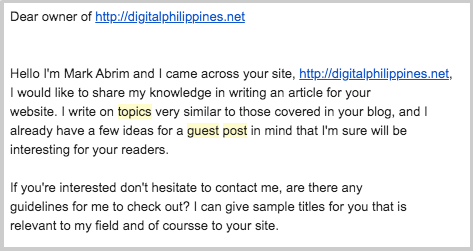
Answering this question:
Hi guys
Need some advice from guys who build Guest post links,
I am building 120-150 links a month, and sometimes it is confusing when it comes choosing guest post topics, Do you guys follow any process to get Guest post topic ideas on scale?

Let's face it. You can't hit and miss in finding blog topics for your guest posting sites. Otherwise, you'll be wasting the time you spent in discovering those sites — especially if you don't get any results from your pitches.
AUTOMATED TOPIC IDEATION PROCESSES GONE WRONG
I've seen several articles discussing how to use a tool to generate hundreds of topic ideas in 5 minutes. While that may be a good choice, people are risking blog titles that are brand-off, or even niche irrelevant if they do that.
Take a look at this example. This is a blog that covers sleeping for a highly targeted audience - sleeping enthusiasts and people who suffer from sleep deprivation, and sleep problems and illnesses. If you push topics outside of sleeping and snoring to that site, you won't get much success.

Meanwhile, a general psychology site like Psychology Today can cover sub-niches under its main blog theme. You see, you can't just make a list of 10 topics and submit it to two different websites with different audience targeting.

NICHE-BASED GUEST BLOGGING IDEATION
Niche-based topic ideation for guest blogging campaigns is okay as long as websites you target for guest posting covers the same audience and have the same topic themes for their blogs.
The best way to solve the problem of overlapping topics for different niches is to categorize your guest blog prospects based on their verticals and topic themes they cover.
This approach can help you ensure you don't hit and miss your approach to pitching your ideas for publishing websites.
5-MINUTE PERSONALIZED GUEST BLOGGING TOPIC IDEATION
The best and still the recommend methodology to get the highest approval rate for guest blog topics and highest content placement rate is to personalize your topic ideas individually to your target publishers.
You can't shortcut topic ideation.
However, if you're doing it at scale, the more you execute the process, the more your content writers or content specialists will now be able to shorten the time spent on it, as they become familiar with each step.
A. CONTENT GAP ANALYSIS
Content gap analysis is finding keyphrases your competitors are ranking on search results and have covered on their blogs - which your blog can potentially publish too.
It's a great value when doing guest blogging, as you are pitching a topic that has the likelihood of bringing in new traffic to their site.
You can start this topic ideation by using Ahrefs. It has a feature that does content gap analysis. Enter the URLs of two or more websites.
The question here is, how can you find your guest blog's competitors blogs?
Do a Google search with related advanced search operator to find related websites of your guest blog prospect.
[ related google ]
Then choose among the sites on the search results and enter their URLs to Ahrefs' Content Gap feature.
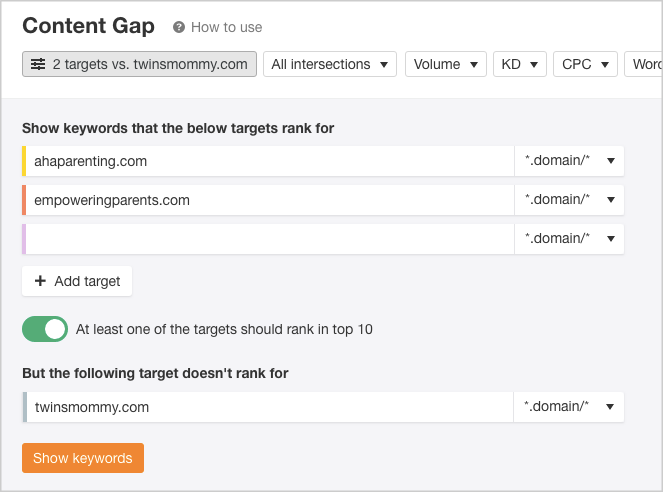
Ahrefs will show keywords your entered sites have been ranking in at least top 10, but your guest blog target doesn't rank for.
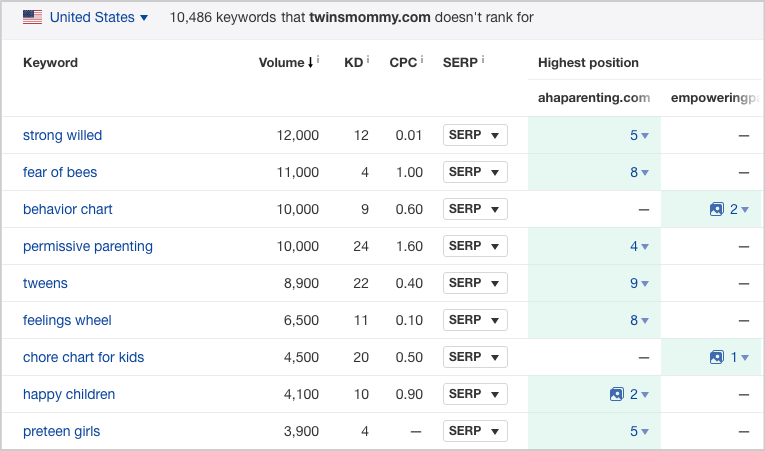
You can create topics out of those keyphrases and include it in your individual pitch as one of your proposed guest blogging ideas to write about.
B. HIGH SEARCHED DEMAND PAGES FROM RELATED SITES
Besides content gap analysis, you can also discover on-demand topics based on their estimated monthly traffic.
To get around this, head over to Ahrefs' Site Explorer and enter one competitor's URL or related site's URL.
Go to "Top Pages" reportwhere you'll see the list of all of its top webpages, which you can sort by estimated organic traffic.
By doing so, you can find out which topics gets lots of searches every month. You can emphasize the value of the topics in your guest post pitch, by stating its estimated organic traffic potential. This means that the guest blog can benefit from the post once it ranks potentially for the keyphrase it targets.
C. ON-DEMAND INDUSTRY TOPICS
If you have topic themes for niches you're pursuing in your guest blogging campaign, you can head straight to Ahrefs' Content Explorer.
Simply search for a topic in Ahrefs' Content Explorer. It will give you the top and recent pages for the topic of your choice.
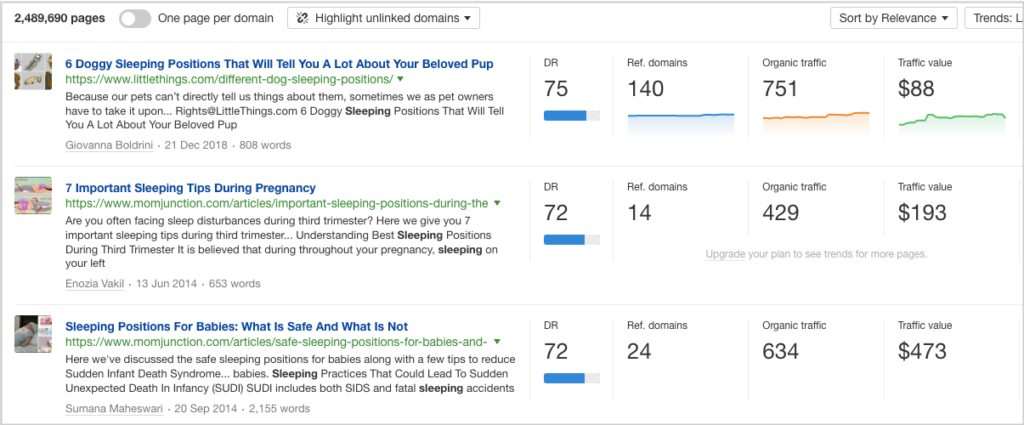
There are three value propositions here.
Referring Domains
You'll find pages (with topics) that have acquired contextual links from other sites. Though links may have been built because of overall site factors, like its overall domain authority, still you'll get an idea that the topic of the page is likely to be linkable.
By pushing this out in your pitch that a topic is linkable based on the data. This would give you a higher likelihood of a topic being accepted by the publisher.
Organic Traffic
Next to referring domains is the organic traffic the page gets on a monthly basis. Here, you'll see if the topic itself has a declining or upward traffic. Avoid topics with declining traffic, and choose ones with upward or steady organic traffic.
Traffic Value
While not all topics have high traffic value, given they're not commercial in nature, you may still find topics that have a good number of traffic value. It's a good unique proposition in your pitch, knowing that if the topic has been covered, it has a potential to drive not just traffic to the site, but also bottom of the line numbers like assisted conversions.
FURTHER READING:
4 Intermediate Tips to Improve Guestographics
SCALING IS SIMPLE WHEN PROCESSES ARE PLACED
Every phase of a link building campaign should have processes in place, ready for execution. So if you want to scale your topic ideation for guest blogging, start documenting your process either using a document platform or Google document. It saves you time when hiring content writers who can do the same process of finding guest blogging ideas fit for your target sites.
How to Improve the Value and Volume in Content Marketing
The uprising trend for the term, “content marketing” is inevitable. Perhaps, the primary reason would be the growing benefits of it as the core part of a business’ inbound marketing strategy.
The enabling power to amplify the reach of the brand to its targeted audience is the benefit that I loved the most with content. It almost becomes the business’ automation tool for brand promotion and traffic generation that allows its visitors to tie up to the brand instantly.
Ensuring that the value and volume of content increases over time is a perfect way to enhance content amplification strategy and to stay ahead of the competition given that almost all brands do content marketing in their space.
Scaling content marketing lies directly on each phase of the content marketing process. Improving the quantity and quality of each element in the phase can positively affect the outcome of each content piece produced by the business.
Here are a few tips to help you get started at scaling your content marketing.
Automate topic discovery
Topic research is a time-consuming task given that it requires an extensive amount of time and energy to digest the market’s needs and align it with the message of the content asset.
However, you can ease the process of finding keywords/topics and at the same time getting assured of its results by using a few handy tools.
First in the list is IFTT. Utilize this tool to receive email updates from sites/blogs that regularly publish thematically-related content assets. Tie IFTT with HARO (use its RSS feed) to generate timely niche-specific news and blog posts right in your inbox.
Buzzsumo is another topic discovery tool that you can also take advantage of. Its filter options allows you to track the most-shared posts in your industry based on the preferred date and content type.
Collaborate with your client’s other departments to get insights about the most common queries your client’s customers asked. Customer inquiries represent the needs of the large portion of the market sector which can strengthen the brand’s mindshare if these inquiries were used as an inspiration for the content.
For small brands, comments from webmasters on their blogs are good opportunities to track questions that your readers want to be answered through your blog posts. Use this plugin created by SEER Interactive to grab all comments on your blog.
Use Content Discovery Scraper List to automate the process of combining content templates with a specific topic (e.g. “The History of Weight Loss”). In almost all industries, this list can be used to get quick inspirations for your blog especially on your site’s first month of content creation.
Start with authors to prospect for more content topics. Use advanced search operators, blog directories and content submission sites to find industry influencers. You can check out this guide for easy influencer prospecting.
Co-authorship
Quality is much more evident when two heads are combined to create a great piece of content (ebook, guest contributions, guide, etc..). The reach of co-authored content asset is being amplified by the combined efforts of both parties involved and by their social and blog’s followers.
Shameless plug: I and Moosa will be launching an awesome link building book soon.
Content conversion
Turning your piece into other content formats is a cost-efficient method in content marketing. For low-budgeted marketing campaigns, content conversion maximizes the value of every piece of content which can give you more time and energy in planning for your future content assets.
For video product reviews, you can convert them into “still images” and upload to image sharing sites. Check out this list of image sharing sites.
Turn your highly linked/most visited and/or most shared blog posts to pages. Pages tend to rank higher on search engines than blog posts which can add more search traffic to your site. Use Google Analytics to track the top ten blog posts with the most number of visits, Ahrefs to identify your blog’s top pages and Social plugins for social shares evaluation.
Content sourcing
Content sourcing is placing your content piece on other related websites to increase your brand’s signals on search engines, absorb followers/readers from those sites and build hard to do things that your competitors can’t replicate (i.e. relationships).
If you want to start or have started with regular contributions, then here are some tips to improve the value of your content efforts:
- Start with those who’ve already linked to you in the post or have shared your posts. There is a higher chance of accepting your submissions from those bloggers since they know the caliber of your content and you have built relationships with them beforehand. Start pitching them by thinking for linking/sharing your content, and then eventually ask if they’re looking for regular columnists.
- Build a content portfolio on your site so you can link to them from your regular contributions. Your site’s inner pages will then pass its link value to other pages where they had linked to.
- Set stricter metrics when prospecting for content placement sites. Domain authority (using Mozbar), SE traffic price (SEMRush metric), engagement (blog comments) and social shares are some key considerations of the quality of the pages. Contributions on these highly-valued domains have higher chances of ranking for long tail keywords.
- Standing out when pitching would really require a solid sample (preferably content published on the client's site - to effectively demonstrate expertise).
These actionable tips came from the one and only, Jason Acidre.
Continuously sharing new industry insights on roundup posts both from closely related and general niches can strengthen your site’s domain authority and influence in your community. Tip: You can use this as an angle when pitching for guest blogs given that this is a proof of your expertise in the field.
Build a solid content team
Continuous improvement on the part of the content workforce is a solid method in scaling content marketing given that the team members are the most important element in content creation.
Kyra Kulk wrote a comprehensive guide on how to develop and maintain a content marketing team. You can check out that post (it’s worth reading!).
Here are some key tips to get you started with running a content marketing team:
- Set strict editorial guidelines for all content pieces (i.e. no duplication, proper external links to authoritative sources, etc..)
- Provide training resources to team members to enhance their skills and improve their output. Tip: Get them read at least two blog posts from Inbound.org that are related to content marketing.
- If you’re not an expert in the industry, then this guide will help you.
Content optimization
Proper optimization of a content piece both for search engines and users helps you win the 50% of the battle. Given that search engines are using relevancy and authority to rank well-optimized pages higher on search results, it is a must to consider to improve the value of your content assets.
Here are a few tips to a proper content optimization:
- Use keywords in the title, header tags and first 50 words of your content.
- Include industry-related terms in the context of your content so it will have a better chance to rank for other long tail phrases (learn the concept of latent semantic indexing here).
- For internal linking, use long-stringed anchor texts to increase their click through rates for the other inner pages of your site. You can also check out this guide about internal linking.
- For guest contributions, link to your site’s related blog posts to get them receive more referral traffic from guest blogs and improve their rankings on search results.
Strategic content promotion
The 50% success of the battle lies on your brand’s content promotion strategy.
Using other inbound marketing channels will help your content promotion perform better in terms of gaining new visitors/subscribers and/or potential customers.
One channel that you shouldn’t miss out is email marketing. Combining its power with content marketing is a solid foundation in brand promotion since these two channels can support each other. Content becomes an email generator for potential customers of the brand whereas emails get the content in front of its interested readers.
Bryan Harris from Video Fruit shared a case study on how he got his first 100 email subscribers using ten email strategies. You can check out that post together with this case study on Smart Passive Income blog and with this eCommerce email marketing tips.
Another effective channel to maximize the value of a content piece is social media advertising (i.e. Facebook ads). Matthew Woodward wrote a case study on the different ROIs he got from testing different Facebook campaigns. He emphasized the use of different images to capture clicks from Facebook users (check out the post to learn more).
My most favorite content promotion method is blogger outreach. This enables the content publisher to establish strong relationships with other webmasters (especially when both parties are given the benefit/value).
Outreach Resources:
- How to Get Influencers to Promote Your Content for Free
- The Definitive Guide to Link Building Outreach
For more content marketing insights, you can subscribe to this blog (use the subscription box below) or follow me on Twitter and Google+.
Creating and Developing Content Assets Like A Pro
Content assets had been one of the greatest investments of almost all size of brands today. It became such a phenomenon in the industry that everyone wants to have a piece of asset for their site's content development.
However, content marketing is not just about creating content pieces. It’s more on delivering the best value to your target audience. Without including your audience as a contributing factor in your marketing campaign, you would be more likely to lose track with your goals/objectives. Remember that your customers are the reasons why your brand exists in the industry. Therefore, they should be given the top priority in your content marketing campaign.
I’ve seen a lot of improvements in content marketing and how those improvements affect the thinking of many content marketers in delivering a useful and targeted content. This made every phase in the content process looks more challenging than before.
Five Stages of a High Quality Content Development
To surely make the most value out of your content efforts, it’s very important to take every stage in the content creation process as a chance to win over your competitors. This may require strategic planning in those stages to truly provide a reliable and useful content piece for your audience.
In this post, I will share to you actionable tips to help you outrank your competitors with every content piece that you will be creating.
Ideation
There are several ways to get ideas for your content that are not only catchy to the eyes of your audience but are also seasonal and/or traffic-based keywords (which means that they can give a boost to the traffic of your site if those keywords/ideas are optimized on your content and your content pieces ranked high on search results for those certain keywords).
Let’s get started..
1. Comments on other site’s content
Blog commenting is not only used for link building purposes but also for finding keywords for your content. If you have a list of authority sites in your mind, you may want to visit once in a while to get some ideas.
I’ll get Moz as my example.
Every post on Moz (the main blog) managed to get an average of a hundred comments just the time they were published on the site.
This Whiteboard Friday edition by Michael King received 119 comments which is a good amount of blog comments for one post.
Those comments would give a significant value when looking for content ideas given that every word commented by a blogger could be words/phrases that they may/might be searching for in the search engines.
What I’m gonna do is to find keywords in the comment section that are related to link building, content and branding (because this is my field!).
By using the Find and Replace in Chrome Web Browser, I was able to find phrases that are related to my keywords.
Oh! An expression!
Finding these keywords is not enough. You have to see whether or not they are the most commonly searched terms in your industry. To do this, we can use Google Keyword Planner (for search volume) or Google Trends (for seasonality).
Let’s see the trend of each keyword.
As you can see, the word “great content” seems like a good keyword and the interest for that keyword progresses over time. Gold!
“Amazing content” (though it may not be a seasonal term for now), looking at its seasonality would give us an idea that it might be an interest-rich keyword for content in the future.
And if you’re targeting an audience located in India and USA, those aforementioned content-related terms is a must to consider for your campaign.
Another Tip: Click the box saying, “email me when new comments are posted” right below the post of your target site, this would help you track if there is a new comment on the blog post (you’ll receive a Wordpress email).
2. Authority Sites through RSS Feeds
Competitive research will never be excluded in every marketing campaign of SEO practitioners given that it would help them identify their strengths and weaknesses as brands which are necessary to bring those campaigns into success.
Determining what authority sites are doing with their blogs based on the content they’re publishing would give you a feel of what you can also do for your content strategy (outranking them with better content than they have).
If you still don’t have any authority site in your list (perhaps, you’re new to the industry), you can use this tool to look for websites that have a large number of subscribers. The reason you want to consider the number of subscribers when finding authority sites is that most of the time, those websites with a large amount of subscribers managed to build a community for their brands. This community could get them share their content on social and provide useful insights (which is commonly about their offerings) in the comment section of their blogs.
Type in your keyword in the search bar of the tool and it will give you a list of websites that are ranked according to the number of subscribers. Use Feedly to get those sites on track. Once in a while, visit those authority sites, read their content pieces and analyze how they create content (based on content format, concept, posting frequency, etc…).
You can check out this huge list of free link building tools to find more link prospects.
3. Repurpose other people’s content
Most of the time, posts that get a lot of attention are those content that are just repurposed from another content (made by them or other brands). This would save you time and money especially if you’re tight with your budget.
Repurposing blog posts to UGC content pieces is a good strategy especially if the original content garnered several shares/links. Outreaching to the linkers/sharers of the original version would yield much better results in terms of outreach response rates.
Original content
Repurposed content
4. Keyword-rich URLs
Authority sites don’t rank easily without optimizing their pages for search (unless they’ve been in the webspace for over 2 years or so). For those sites that are new in the industry (6 months to 2 years) but tend to get to the top spots of search results for targeted keywords, there must be some on-page optimization that they are doing for their pages.
Let’s take Kaiserthesage as my example (do you still wonder why I always link to him?).
By simply looking at each url of every page, you have an idea of what keyword the webmaster is trying to rank for that page.
Or you can use Ahrefs to find their top pages (where you can see their keyword-rich URLs). Click on the top pages.
5. Anchor texts of referring domains of your competitors’ content
If you’re tired of searching for an idea that doesn’t have a potential to gain continuous traffic to your site (through search), you should make some analysis of your competitor’s backlink profile. You won’t be getting the list of referring domains that linked to your competitor’s site/page (to reach out and get the same types of links). Instead, you will only look at the anchor texts that your competitor’s referring domains used to link to your competitor’s page.
Get those anchor texts and put them in a spreadsheet. Use your keyword tool to identify which of them could be considered gold for search volume.
6. Ultimate Industry Guides
Not all industry guides are perfect guides. Every portion in the guide would support the main subject/theme of the content. However, those portions are just descriptions, which means that they are not so detailed (which is a good content idea that you can use for your own content piece).
Let’s give an example.
There are portions in this industry guide that are not so detailed but when you see it in the overall view, it is a comprehensive and useful content. Use those portions to create another content piece (not necessarily be an industry guide, could be visuals) but ensure that the content piece is specifically optimize for the keyword you’re looking at.
7. FAQs
You’re familiar with this. I’m sure a lot of brands have their Frequently Ask Questions page to better serve their customers by answering their most common questions. This would help the brand to know any problems that their customers might be experiencing when they use their products (questions that are not answered or solved by their FAQs page).
FAQ pages could also be used for content ideation. What you will do is to get all the listed questions, place them all in a spreadsheet and take each one of them into Google search (don’t put all the phrases; pick up those related terms in the question).
If there is any page that is already targeting those questions, you could put another phrase in Google search until you find one that has not yet been targeted by someone.
8. Dissect Google+ Hangout videos
You will not strip the video into shorter ones but you want to know what ideas/insights have been discussed in the hangout that can be covered in a blog post (or any other content format).
Listen to the hangout video (it would be great if you could listen to a group interview). There are tons of ideas that are accidentally shared by industry experts (they could just say anything that is sometimes not specifically pointing to the topic they’re discussing about).
List those points in the spreadsheet and get back to the list once you’re done with the content ideation.
9. Two seemingly-irrelevant but relevant topics
Connections are what would make your content looks more natural and appealing to your readers. You could connect two seemingly-unrelated topics and turn that combined idea into a blog post.
You might need a thorough research to make this thing works! It would take time and effort to create awesome piece like this.
Imagine if you can create several pieces like this (related to your industry terms), you might be surprised by how many people would link to your content or at least share it to their peers.
10. Niche-related communities
There is at least one community related to your field that could be a useful resource for your content development assets. Use Google search to find at least one (inurl:forum + “your industry”) and identify if that is really awesome (users participate well and not spammy).
Use the intext:query to find niche-specific phrase/ideas.
Try this one: intext:your keyword + site:yourforum.com
You should only use one word (your main keyword) to find relevant ideas in the forum.
Example:
As you can see, there are tons of ideas that you could use to develop your own content. Use again your preferred keyword tool to get the highest search volume and use your personal judgment on which keyword you’ll be using for your own content.
11. Anchor texts of linking domains to your site.
You can’t control the anchor texts that other webmasters are using to link to you (unless you’re the one who approach them about those link opportunities). They might be using phrases/keywords which are uncommon to you but related to your industry terms.
This is great if you have that list of anchor texts that your linkers link to you. However, you can use those texts to create a solid content that matches to each of the phrase. Simply, find a phrase you have not optimized yet for your site. Create a page targeting that phrase/keyword and build links to it (just like what you did for your site’s other pages).
12. Branded link mentions.
You may be tracking every site/page that linked to your website. If you’re already doing this for link building purposes, make sure you do it also for your content strategy. Those webmasters (those who linked to you) have reasons why they did that linking. If you will know their reasons of linking to you, you can have good partnership/relationships with them. Who knows? They might collaborate with you to create an awesome content piece.
You could also interview the person who linked to you (especially if that is a customer). Ask him what pushes him to give credit or mention your brand on his blog/page. Incentivize him to encourage him to talk more about you. Interviewing that person would improve your site’s performance given that people would like to know the feedback(s) from the users of your product.
Remember that you don’t want to make the content be a self-promotional one. Add some twists in it (like asking the person, “Give me some experiences in using the product that almost pushes you to stop using it?”
People love brands that are transparent with their situations/offerings as this would prove how they truly value their customers.
13. Interview speakers of upcoming webinars/events.
If you’re looking for an easy content piece, this one is good for you. The only thing that you need is to do is to make a list of events (webinar/conference/seminar) that people in your community (local) is so excited to participate in. Gather all the details about each event like the names of the speakers, location and other important details that could help your content (if you’re using this as an angle) to be detailed and useful for your followers.
I wrote a piece of content a few weeks ago about a conference that will be held here in the Philippines. Review that post on how I use event details to make the post more valuable to my local followers.
14. Product Reviews
You have a product and you got product reviews in the past. You can use that to make an awesome content piece for your brand.
Here is what you can do.
Look at the sites (your own website if you allow ratings/reviews for each of your product or product review sites where your product had been mentioned). Some websites allow you to sort reviews based on ratings so you can get the most value out of those comments/reviews. Check industy-related terms that people had used in their comments. Those terms is what you’ll be using for your content piece given that those are informational keywords (people are using those phrases in their searches).
15. Intext Query
You’re probably familiar with this query. You can use this to find keywords that are placed on any sites (that you should be analyzing as to the content format).
To get the best content ideas from sites that you’re not almost familiar with, don’t add any specific website to this query. Just use the plain query, like this: intext:”financial calculator”.
The reason for doing this is that you want to see all the pages where that keyword/phrase has been mentioned. You will probably see the top pages ranking for that keyword (most of the time, those are authority sites in your industry). In my opinion, you can’t get much value from those pages (as they already had built an authority in the space). You want pages that are still new but are authoritative already in terms of followers/readers and analyze what they did to create a page targeting that keyword.
Click on the lower pages (page 7 or higher) to see how are those sites use that keyword in their content assets.
16. Ask someone about your brand through email or social.
Know what captivates your readers’ interest by asking questions to them. You may have not known they’re waiting for you to reach out and ask their content suggestions. This is one of the most effective ways to get content ideas as those customers/readers/followers is part of the group (target audience) that you’re trying to please with your content. If one of them replies and suggest one idea for your content, don’t ignore him. He might also suggest a content format (infographic, blog post, etc..) that you had never done before for your brand which can make a significant difference to what your site is already doing for them.
17. Use tools to organize your content.
I have Mindmeister in my mobile phone which I use to organize my content ideas and add more to it as I think another idea. The best content ideas that I had for my recent posts came from nowhere. When I’m not facing at my computer, those ideas pumped up!
You can try this technique. It might work for you also.
Another tool that you can also use is wordcloud. This will help you see the common keyword/phrase and some combined thoughts that you can use for your content.
Research
Sixty-five percent of the respondents in the survey conducted by the team of Colleen Jones say that web is an unreliable source.
But there’s still some (45%) who’re looking for sources from web for their own research/content. The reason is that people go to web to get true help or advice. So if you want to get the most value out of your content, you have to consider the credibility of your sources/references which you will use to point out facts/info/data that are relevant to the topic/subject of your content piece.
Aside from what I mentioned in this post about attributes/characteristics that I consider valuable factors when looking for resources for content, credibility should also be taken into consideration.
Why do you have to look for credible sources?
Most often than not, people get confused with the content they searched on the web given that the cited sources are not really credible. The sources were outdated and they don’t really support the main point that the content wants to convey.
This is something that you should be looking at when looking for credible sources.
Now let’s know what factors that would make the source(s) credible (added info to what I mentioned in that post about content resources)
- It has a distinct voice. When the content publisher of that source says something, everyone listens to him given that he has proven his authority and influence to his audience. So if you’re looking for credible sources, determine if they have distinct voices (or personality). Does their audience agree with their saying/thoughts? Does the brand owner get several complaints rather than compliments/praises?
- It makes a clear point. The source should only give emphasis on one subject. I haven’t seen any content piece that already tackles all the terms in the industry. There are pieces that managed to do that (ultimate guides) but most of the time, there’s one topic that the content asset is specifically talking about. Sources are credible when they managed to show off their expertise through those sources (pointing only to one topic).
- It is useful. As you always get the most useful sources, you enable your content to become more credible in the eyes of your audience (users will learn much from your content and to its sources). This would give them a reason to come back to your site once in a while (to read/consume your content).
- It guides you to the next step. A source always guides to your next step of learning. If your source does not do it for you, it will not also guide your users. Make sure that you are satisfied first with the value that you’re getting from your sources before enticing others to be satisfied with your content. Otherwise, your users will not read those sources for additional knowledge.
Note: Not because it ranks in one of the top five spots in the search results for the target keyword doesn’t mean it is a credible source.
Here are a few ways to get sources for your content:
- Use this tool to find industry-related sources/references. Use this as your own advantage to identify which of them could pass credibility and value to your content. Data-driven content is a good source if the content publisher provides source documents of their content.
- Expert’s insights/advices. Get help from people who know their stuff really well. This post by Rohit Palit is a good example of this. Below that page, there is a section that allows experts to share their own insights about the topic.
Indeed, research takes time. To maximize your research efforts, ensure that you only get credible and relevant sources for your content.
Other Resource:
6 Ways to Find Data to Support Your Content
Conceptual Framework
All the data/sources should be gathered at one place. This phase, “Conceptual Framework” would ensure that your content has a logical flow of information.
One of the mistakes of every blogger or content publisher is gathering all the data at one place without even arranging every single thought that they collected. This would look like a scratch paper (scattered ideas).
Note: There’s no rule in the method of outlining your ideas. Use your own if you already have one.
But here are some tools (they’re the common, ha!) that you can try to make your ideas flow smoothly within your content:
- Excel Spreadsheet. One way to organize your ideas is using an excel spreadsheet. Make sure that you add a column for “what is lacking” to take down notes on what is lacking in your resources so you can add insights/hooks to it to improve the context of your content.
- Problem-to-Recommedation Table. This an effective tool to use when you’re creating a guide (how-to) that is focused on helping your target audience solve their own problems. Use this spreadsheet to list down all those problems and take down notes for recommendations.
- Visualization. It’s easy to create a content when you can see the whole picture of it. Visualization allows you to do this by picking up the main principles/ideas and visualize them in a good format.
- Basic Outline. Use your document tool for this one (e.g. Microsoft Word).Here’s an example of a basic outline.
Optimization
I already covered this phase in my post about content promotion. But for additional tips, here are some that you can apply for your content piece.
- Based on the list of anchor texts you’ve gathered earlier, pick up the best ones and use it to optimize your content. Additionally, you can use this query: (site:abc.com inanchor:content) to find pages where your competitor used anchor texts related to your industry terms.
Make sure that you strategically use those anchor texts to ensure that you’re also passing value to your site’s other content assets. You can also use those anchor texts for your content distribution efforts like guest posts.
- Optimize the page with the basic on-page SEO. Putting your keyword at the page’s title tag, H1 and at the first sentence of your page would help your page to rank high on SERPs.
It’s also best to use the exact keyword at the first place of your title (there’s an added factor for rankings when you use this).
- Link to your site’s other content assets (especially to your money pages or your top converting pages). Use Google Analytics to find your top converting pages.
You can link to those pages strategically when you optimize your future content assets.
The most common mistake of webmasters is the use of generic words (e.g. click here) as anchor texts for their content. Though you don’t want to use your exact match anchor texts (so as not to have anchor text over optimization), the use of generic words could be replaced by using your alternatives (partial match, long-stringed, etc..) which is more powerful to use than generic words.
- Don’t worry about keyword density. Focus more on getting links for your content. As long as your keywords are positioned in the right spots (title, h1, first sentence) of your content, you don’t have to make an effort counting how many times you use that keyword alongside your page.
Here is a cool video by Brian Dean about the upside down guest post (where you can get tips on how to optimize your page for search engines and users).
Content Placement
Reminder: There’s no rule in determining where to place your content (on your site or other’s site(s) – guest posts).
But here are a few tips by Moosa Hermani on how to determine if the site (where you will place your guest post on) matches to your brand.
“I always keep few things in mind when reaching out to any place (for guest post or my content)” – M.Hemani
- Is my audience there?
- Do they agree my core principles (for instance I do not like Google's idea of hiding keyword data in GA. If there is a great website who have an opinion that is negative to this then I probably will drop the idea of placing my content there as this differs my ideology)
- Do they have a positive name in the market?
- DA (obviously)
- Will I be able to grab some traffic and make them my continuous reader?
Using this list of guidelines when identifying the right site/blog to place your content would help you get the most value of your content distribution efforts.
Other Resources:
Conclusion:
Strategic planning is necessary to every marketing campaign (the same goes with your content marketing). If you perform really well for each phase (ideation to content placement), you’ll be surprised that you almost win half of the battle. The other half is obviously promoting your content.
If you're looking for high quality links to support your content and grow your business, get in touch with us for effective link building services.



